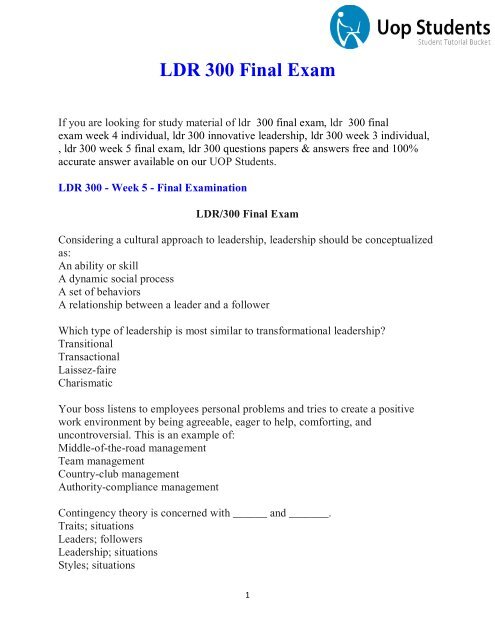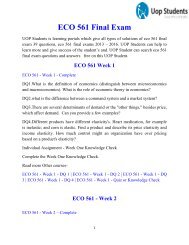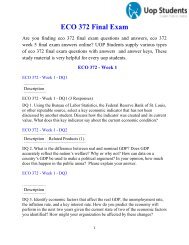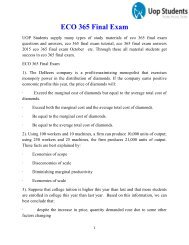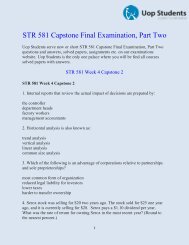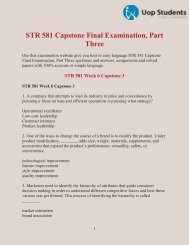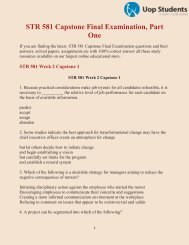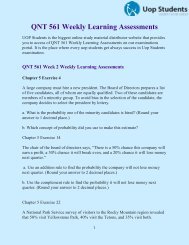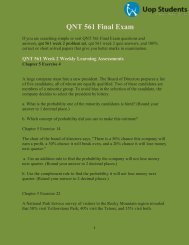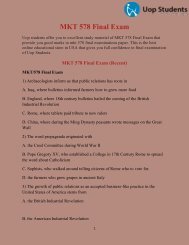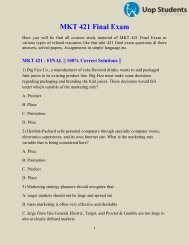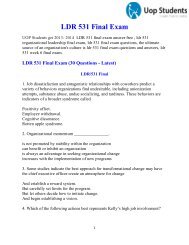LDR 300 Final Exam | LDR 300 Week 4 Individual - UOP Students
UOP Students is the online education store of ldr 300 innovative leadership, ldr 300 questions papers & answers free,ldr 300 week 5 final exam,ldr 300 week 3 individual LDR 300 Final Examinations that offers you different or easy study material. Get more information's visit our website... http://www.uopstudents.com/ldr-300
UOP Students is the online education store of ldr 300 innovative leadership, ldr 300 questions papers & answers free,ldr 300 week 5 final exam,ldr 300 week 3 individual LDR 300 Final Examinations that offers you different or easy study material. Get more information's visit our website... http://www.uopstudents.com/ldr-300
Create successful ePaper yourself
Turn your PDF publications into a flip-book with our unique Google optimized e-Paper software.
<strong>LDR</strong> <strong>300</strong> <strong>Final</strong> <strong>Exam</strong><br />
If you are looking for study material of ldr <strong>300</strong> final exam, ldr <strong>300</strong> final<br />
exam week 4 individual, ldr <strong>300</strong> innovative leadership, ldr <strong>300</strong> week 3 individual,<br />
, ldr <strong>300</strong> week 5 final exam, ldr <strong>300</strong> questions papers & answers free and 100%<br />
accurate answer available on our <strong>UOP</strong> <strong>Students</strong>.<br />
<strong>LDR</strong> <strong>300</strong> - <strong>Week</strong> 5 - <strong>Final</strong> <strong>Exam</strong>ination<br />
<strong>LDR</strong>/<strong>300</strong> <strong>Final</strong> <strong>Exam</strong><br />
Considering a cultural approach to leadership, leadership should be conceptualized<br />
as:<br />
An ability or skill<br />
A dynamic social process<br />
A set of behaviors<br />
A relationship between a leader and a follower<br />
Which type of leadership is most similar to transformational leadership?<br />
Transitional<br />
Transactional<br />
Laissez-faire<br />
Charismatic<br />
Your boss listens to employees personal problems and tries to create a positive<br />
work environment by being agreeable, eager to help, comforting, and<br />
uncontroversial. This is an example of:<br />
Middle-of-the-road management<br />
Team management<br />
Country-club management<br />
Authority-compliance management<br />
Contingency theory is concerned with ______ and _______.<br />
Traits; situations<br />
Leaders; followers<br />
Leadership; situations<br />
Styles; situations<br />
1
Leadership focuses on the ________.<br />
Importance of lateral and upward influence patterns<br />
elimination of dependency in relationships<br />
ways to increase a leader's following<br />
downward influence of a leader on his or her followers<br />
Which of the following leadership theories expects the leader to continually be<br />
concerned about subordinate motivation?<br />
Contingency theory<br />
Situational leadership theory<br />
Leader-member exchange theory<br />
Path-goal theory<br />
Argued that the major activities of management and leadership are played out<br />
differently; but both are essential to an organization:<br />
Jago<br />
Bass<br />
Kotter<br />
Zaleznik<br />
According to research, one way women can advance in leadership is<br />
By acting masculine and assertive, and not in feminine ways.<br />
By blending individualized consideration with inspirational motivation.<br />
By strongly resisting stereotype threats.<br />
By leading in a more democratic manner than men.<br />
In the skills model, which of these is a general cognitive ability?<br />
Problem-solving skills<br />
Information processing<br />
Motivation<br />
Knowledge<br />
Although there are clear differences between management and leadership,<br />
Management is more valued than leadership.<br />
There is little research to support one or the other.<br />
Leadership is more valued than management.<br />
The two constructs overlap.<br />
2
Mary has managed the mailroom for 2 years. Management views Mary as a person<br />
with special leadership talent, such as intelligence, sociability, and determination.<br />
What approach is management using in assessing Mary?<br />
Trait approach<br />
Managerial grid approach<br />
Attribution approach<br />
Styles approach<br />
The team leadership model puts who or what in the driver's seat of team<br />
effectiveness?<br />
Leadership<br />
Satisfying needs<br />
Leaders<br />
Management<br />
The following traits are associated with charismatic leadership:<br />
Intelligence, self-confidence<br />
Physical attractiveness, height<br />
Desire for power, desire to help others<br />
Self-monitoring, impression management<br />
Critical factors for developing a cultural based leadership development program<br />
may include:<br />
Focuses on the organization as a whole rather than the individual, demographic<br />
information, and formal data gathering.<br />
Focuses on all levels of an organization from the individual to the wider<br />
organization, gathers ethnographic data, and looks at many aspects of cultures.<br />
There are no critical factors. Leaders should be sent to various countries and<br />
allowed to learn that way.<br />
Starts the evaluation at the assessment phase, gathers formal data, and focuses on<br />
the language of the participants.<br />
In which way are leadership and power often approached?<br />
From the perspective of the follower<br />
As positional power<br />
As a relational concern for both leaders and followers.<br />
As a form of coercion<br />
Subordinates who have strong needs for affiliation prefer which type of leadership<br />
behavior?<br />
3
Participative<br />
Achievement oriented<br />
Supportive<br />
Directive<br />
Questionnaires on situational leadership often ask for respondents to look at<br />
specific applications of leadership styles within situations, which may result in:<br />
Wide range of responses that are hard to validate<br />
Results that are not in favor of situational leadership<br />
Negative perceptions toward the organizations<br />
Biased results in favor of situational leadership<br />
How does servant leadership differ from path-goal theory?<br />
Is unconcerned with the way leaders should treat followers.<br />
Makes the need for task completion necessary before relationships can thrive.<br />
Focuses on the need for leaders to perfect themselves before helping others.<br />
Focuses on the behaviors leaders should exhibit to put followers first.<br />
Of the Big Five personality factors, which is the most strongly associated with<br />
leadership?<br />
Extraversion<br />
Openness<br />
Emotional intelligence<br />
Social status<br />
Which best describes the reason situational leadership is so practical for managers<br />
to use?<br />
Its specific nature<br />
Its straightforward nature<br />
Assist in relating demographics to leadership<br />
It is only applicable to lower-level managers<br />
Of the bases of power, research indicates that ________ power is most effective.<br />
Reward<br />
Personal<br />
Legitimate<br />
Coercive<br />
The leader is at the core of group change and activity, representing the backbone of<br />
the group or organization. Leadership is viewed as:<br />
4
Leadership as an act<br />
Personality perspective<br />
Leadership as a behavior<br />
Focus of group processes<br />
Critical life events affect authentic leadership because<br />
They reinforce patterned behaviors.<br />
They influence a multitude of people.<br />
They are a common occurrence.<br />
They act as a catalyst for change.<br />
What type of power did Bill Gates have when he and Paul Allen started Microsoft?<br />
Coercive<br />
Referent<br />
Expert<br />
Legitimate<br />
If your superior tells you that she will offer you a raise provided you perform<br />
additional work beyond the requirements of your job, he/she is exercising<br />
________ power.<br />
coercive<br />
reward<br />
legitimate<br />
personal<br />
The Ohio State studies considered the behaviors of consideration and initiating<br />
structure as:<br />
Cause and effect<br />
High value and low value<br />
Distinct and independent<br />
Interdependent<br />
During a speech given by your department director, he repeatedly emphasizes the<br />
importance of reaching goals set by the organization. He then goes on to lay out<br />
the framework to accomplish the goals. According to contingency theory, which<br />
best describes your director?<br />
High LPC score<br />
Relationship motivated<br />
Task motivated<br />
Position power<br />
5
Liz is a team leader at a local grocery store. Recently, her boss said that she needs<br />
to address the negative attitudes of employees. To try and fix this problem, she has<br />
begun awarding gift-cards to employees who have great attitudes. What internal<br />
leadership intervention is Liz addressing?<br />
Satisfying needs<br />
Managing conflict<br />
Facilitating decisions<br />
Goal focusing<br />
Your parents and older siblings are all successful elected officials. After<br />
graduation, it is suggested by many that you should seek office and, in turn, offer<br />
you their support. Which best describes the leadership approach being<br />
demonstrated?<br />
Style approach to leadership<br />
Leadership as a process<br />
Trait perspective<br />
Expert power<br />
To create change, transformational leaders ______________.<br />
Value out-group member's opinions.<br />
Focus on the task at hand.<br />
Leave followers to work on their own.<br />
Become strong role models for their followers.<br />
<strong>Week</strong> 1<br />
<strong>LDR</strong> <strong>300</strong> - <strong>Week</strong> 1 - DQ 1 (3 Responses)<br />
DQ 1. What are some differences between leadership and management? How do<br />
these differences affect an organization ?<br />
<strong>LDR</strong> <strong>300</strong> - <strong>Week</strong> 1 - DQ 2 (3 Responses)<br />
DQ 2. What is effective leadership? What obstacles may hinder effective<br />
leadership? What tools effectively reduce leadership obstacles in an organization ?<br />
<strong>LDR</strong> <strong>300</strong> - <strong>Week</strong> 1 - Leadership and Management Paper<br />
<strong>Individual</strong> Assignment - Leadership and Management Paper<br />
6
Write a 700- to 1,050-word paper in which you select a past or present public or<br />
political figure, as long as he or she is not mentioned in the readings.<br />
Address the following points in your paper:<br />
· In what ways is this person a leader? In what ways is this person a manager?<br />
· What different leadership roles and functions does this person fulfill? How<br />
are these roles similar? How are they different?<br />
· What obstacles has this person encountered as a leader?<br />
· Is this person an effective leader based on common measures for success?<br />
· Provide a rationale for your answers.<br />
Format your paper consistent with APA guidelines.<br />
<strong>Week</strong> 2<br />
<strong>LDR</strong> <strong>300</strong> - <strong>Week</strong> 2 - DQ 1 (3 Responses)<br />
DQ 1. How does an individual’s personality affect his or her leadership traits?<br />
What traits serve a leader well? What traits do not? Explain your answer.<br />
<strong>LDR</strong> <strong>300</strong> - <strong>Week</strong> 2 - DQ 2 (3 Responses)<br />
DQ 2. What methods exist to develop leaders in an organization? What methods<br />
does your organization use? Why? Have any methods been counterproductive? In<br />
what ways?<br />
<strong>LDR</strong> <strong>300</strong> - <strong>Week</strong> 2 - Learning Team Discussion Question<br />
Learning Team Discussion Question<br />
What examples of managerial derailment have you experienced in an<br />
organizational setting? Could they have been avoided? If so how? If not, why not?<br />
7
<strong>Week</strong> 3<br />
<strong>LDR</strong> <strong>300</strong> - <strong>Week</strong> 3 - DQ 1 (3 Responses)<br />
DQ 1. Identify a public or political leader. What kind of power does this leader<br />
possess? What influence tactics does this leader normally use based on his or her<br />
power? Provide a specific example of an influence tactic this person has not used.<br />
<strong>LDR</strong> <strong>300</strong> - <strong>Week</strong> 3 - DQ 2 (3 Responses)<br />
DQ 2. What are some examples of nonprofit organizations? What unique<br />
challenges exist for their leaders? What characteristics and tools might a nonprofit<br />
organization’s leader utilize to overcome these challenges ?<br />
<strong>LDR</strong> <strong>300</strong> - <strong>Week</strong> 3 - Leadership and Power Paper (2 Sets)<br />
Resource: The Prime Minister’s Powerful Better Half Mini Case<br />
Review The Prime Minister’s Powerful Better Half.<br />
Answer the questions at the end of the Mini Case.<br />
Address the following:<br />
· Review the Leader Motives in Ch. 5 of Leadership: Enhancing the Lessons<br />
of Experience. How would you characterize Ho Ching’s motives?<br />
· Review Highlight 5.3 in Leadership: Enhancing the Lessons of Experience.<br />
What role, if any, do managerial differences based on gender play here?<br />
Format your paper consistent with APA guidelines.<br />
<strong>LDR</strong> <strong>300</strong> - <strong>Week</strong> 3 - Leadership Profile<br />
Learning Team Assignment - Leadership Profile<br />
Your company’s vice president of human resources has approached your team for<br />
assistance in recruiting and developing your organization’s future leaders. The vice<br />
president has asked your team to brainstorm, research, and prepare a written<br />
profile.<br />
Resources: University Library, Internet, <strong>Week</strong> Three readings<br />
8
Write a 1,750- to 2,450-word profile.<br />
Select one of the following organizations to use as your company in the profile:<br />
· Apple®<br />
· Southwest Airlines Co.®<br />
· Starbucks®<br />
· National Football League®<br />
· Sony Corporation of Americ<br />
Include the following in your profile:<br />
· Compare-and-contrast of common leadership traits in this industry<br />
· Methods for developing leaders in this industry<br />
· Strategies for how industry leaders balance competing values and priorities<br />
· Proposal to avoid managerial derailment and failure<br />
Format your profile consistent with APA guidelines.<br />
<strong>LDR</strong> <strong>300</strong> - <strong>Week</strong> 3 - Learning Team Discussion Question<br />
Learning Team Discussion Question<br />
In The Art and Science of Leadership, Nahavandi writes about the dark side of<br />
power. Provide an example. What organizational factors contributed to the leader’s<br />
behavior? What were consequences of the behavior ?<br />
<strong>Week</strong> 4<br />
<strong>LDR</strong> <strong>300</strong> - <strong>Week</strong> 4 - DQ 1 (3 Responses)<br />
9
DQ 1. How do effective leaders build relationships with superiors and peers? What<br />
specific approaches must a leader employ when interacting with superiors and<br />
peers ?<br />
<strong>LDR</strong> <strong>300</strong> - <strong>Week</strong> 4 - DQ 2 (3 Responses)<br />
DQ 2. What constitutes participatory management? Under what conditions would<br />
you propose participatory management? What are its advantages and<br />
disadvantages?<br />
<strong>LDR</strong> <strong>300</strong> - <strong>Week</strong> 4 - Learning Team Discussion Question<br />
Learning Team Discussion Question<br />
What obstacles exist for leaders involved in participatory management? What<br />
methods may a leader employ to overcome these obstacles?<br />
<strong>LDR</strong> <strong>300</strong> - <strong>Week</strong> 4 - Strategies for Building Effective Relationships Paper<br />
<strong>Individual</strong> Assignment - Strategies for Building Effective Relationships Paper<br />
Your uncle owns a midsized manufacturing business for which you worked<br />
between high school graduation and college. You were involved in many no<br />
managerial operations, from distribution to manufacturing experience. As a new<br />
graduate, you seek employment.<br />
Your uncle has offered you a position as the new product development project<br />
leader. If you accept this position, you must address the following concerns:<br />
· Revenue on the business’ standard products has dropped significantly in the<br />
past 3 years.<br />
· There are no new ideas on the horizon.<br />
· No one is leading project managers.<br />
· The last project leader left the business because of conflicts with peer<br />
managers and immediate supervisors.<br />
After careful consideration, you accept the job offer.<br />
10
Write a 1,750- to 2,450-word paper and address the following concepts:<br />
· Basic leadership skills you need to succeed<br />
· Methods you use to build effective relationships with superiors and peers<br />
· What role you will play regarding participatory management in the business<br />
Format your paper consistent with APA guidelines.<br />
<strong>LDR</strong> <strong>300</strong> - <strong>Week</strong> 4 - Understanding Strategic Forces Paper<br />
Learning Team Assignment - Understanding Strategic Forces Paper<br />
Resource: The Art and Science of Leadership<br />
Read Exercise 7-1 in The Art and Science of Leadership.<br />
Provide a written, in-depth analysis of the two candidates in the exercise and a<br />
rationale for your final recommendation.<br />
Prepare answers to the Understanding Strategic Forces worksheet.<br />
Review the two candidates and their qualifications in terms of environment,<br />
strategy, culture, structure, technology, and leadership.<br />
Explain which leadership each candidate represents.<br />
Address unique challenges of leaders in a nonprofit organization, such as the junior<br />
high school in the exercise.<br />
Format your paper consistent with APA guidelines.<br />
<strong>Week</strong> 5<br />
<strong>LDR</strong> <strong>300</strong> - <strong>Week</strong> 5 - DQ 1 (3 Responses)<br />
DQ 1. Provide an example of change that may take place in an organization. How<br />
may that change be perceived, based on a person’s position?<br />
11
<strong>LDR</strong> <strong>300</strong> - <strong>Week</strong> 5 - DQ 2 (3 Responses)<br />
DQ 2. How problems are routinely solved in organizations? As a leader, what<br />
methods would you propose for creative problem-solving?<br />
<strong>LDR</strong> <strong>300</strong> - <strong>Week</strong> 5 - <strong>Final</strong> <strong>Exam</strong>ination<br />
<strong>LDR</strong>/<strong>300</strong> <strong>Final</strong> <strong>Exam</strong><br />
Considering a cultural approach to leadership, leadership should be conceptualized<br />
as:<br />
An ability or skill<br />
A dynamic social process<br />
A set of behaviors<br />
A relationship between a leader and a follower<br />
Which type of leadership is most similar to transformational leadership?<br />
Transitional<br />
Transactional<br />
Laissez-faire<br />
Charismatic<br />
Your boss listens to employees personal problems and tries to create a positive<br />
work environment by being agreeable, eager to help, comforting, and<br />
uncontroversial. This is an example of:<br />
Middle-of-the-road management<br />
Team management<br />
Country-club management<br />
Authority-compliance management<br />
12
Contingency theory is concerned with ______ and _______.<br />
Traits; situations<br />
Leaders; followers<br />
Leadership; situations<br />
Styles; situations<br />
Leadership focuses on the ________.<br />
Importance of lateral and upward influence patterns<br />
elimination of dependency in relationships<br />
ways to increase a leader's following<br />
Downward influence of a leader on his or her followers<br />
Which of the following leadership theories expects the leader to continually be<br />
concerned about subordinate motivation?<br />
Contingency theory<br />
Situational leadership theory<br />
Leader-member exchange theory<br />
Path-goal theory<br />
Argued that the major activities of management and leadership are played out<br />
differently; but both are essential to an organization:<br />
Jago<br />
Bass<br />
Kotter<br />
Zaleznik<br />
According to research, one way women can advance in leadership is<br />
13
By acting masculine and assertive, and not in feminine ways.<br />
By blending individualized consideration with inspirational motivation.<br />
By strongly resisting stereotype threats.<br />
By leading in a more democratic manner than men.<br />
In the skills model, which of these is a general cognitive ability?<br />
Problem-solving skills<br />
Information processing<br />
Motivation<br />
Knowledge<br />
Although there are clear differences between management and leadership,<br />
Management is more valued than leadership.<br />
There is little research to support one or the other.<br />
Leadership is more valued than management.<br />
The two constructs overlap.<br />
Mary has managed the mailroom for 2 years. Management views Mary as a person<br />
with special leadership talent, such as intelligence, sociability, and determination.<br />
What approach is management using in assessing Mary?<br />
Trait approach<br />
Managerial grid approach<br />
Attribution approach<br />
Styles approach<br />
The team leadership model puts who or what in the driver's seat of team<br />
effectiveness?<br />
14
Leadership<br />
Satisfying needs<br />
Leaders<br />
Management<br />
The following traits are associated with charismatic leadership:<br />
Intelligence, self-confidence<br />
Physical attractiveness, height<br />
Desire for power, desire to help others<br />
Self-monitoring, impression management<br />
Critical factors for developing a cultural based leadership development program<br />
may include:<br />
Focuses on the organization as a whole rather than the individual, demographic<br />
information, and formal data gathering.<br />
Focuses on all levels of an organization from the individual to the wider<br />
organization, gathers ethnographic data, and looks at many aspects of cultures.<br />
There are no critical factors. Leaders should be sent to various countries and<br />
allowed to learn that way.<br />
Starts the evaluation at the assessment phase, gathers formal data, and focuses on<br />
the language of the participants.<br />
In which way are leadership and power often approached?<br />
From the perspective of the follower<br />
As positional power<br />
As a relational concern for both leaders and followers.<br />
As a form of coercion<br />
15
Subordinates who have strong needs for affiliation prefer which type of leadership<br />
behavior?<br />
Participative<br />
Achievement oriented<br />
Supportive<br />
Directive<br />
Questionnaires on situational leadership often ask for respondents to look at<br />
specific applications of leadership styles within situations, which may result in:<br />
Wide range of responses that are hard to validate<br />
Results that are not in favor of situational leadership<br />
Negative perceptions toward the organizations<br />
Biased results in favor of situational leadership<br />
How does servant leadership differ from path-goal theory?<br />
Is unconcerned with the way leaders should treat followers.<br />
Makes the need for task completion necessary before relationships can thrive.<br />
Focuses on the need for leaders to perfect themselves before helping others.<br />
Focuses on the behaviors leaders should exhibit to put followers first.<br />
Of the Big Five personality factors, which is the most strongly associated with<br />
leadership?<br />
Extraversion<br />
Openness<br />
16
Emotional intelligence<br />
Social status<br />
Which best describes the reason situational leadership is so practical for managers<br />
to use?<br />
Its specific nature<br />
Its straightforward nature<br />
Assist in relating demographics to leadership<br />
It is only applicable to lower-level managers<br />
Of the bases of power, research indicates that ________ power is most effective.<br />
Reward<br />
Personal<br />
Legitimate<br />
Coercive<br />
The leader is at the core of group change and activity, representing the backbone of<br />
the group or organization. Leadership is viewed as:<br />
Leadership as an act<br />
Personality perspective<br />
Leadership as a behavior<br />
Focus of group processes<br />
Critical life events affect authentic leadership because<br />
17
They reinforce patterned behaviors.<br />
They influence a multitude of people.<br />
They are a common occurrence.<br />
They act as a catalyst for change.<br />
What type of power did Bill Gates have when he and Paul Allen started Microsoft?<br />
Coercive<br />
Referent<br />
Expert<br />
Legitimate<br />
If your superior tells you that she will offer you a raise provided you perform<br />
additional work beyond the requirements of your job, he/she is exercising<br />
________ power.<br />
coercive<br />
reward<br />
legitimate<br />
personal<br />
The Ohio State studies considered the behaviors of consideration and initiating<br />
structure as:<br />
Cause and effect<br />
High value and low value<br />
18
Distinct and independent<br />
Interdependent<br />
During a speech given by your department director, he repeatedly emphasizes the<br />
importance of reaching goals set by the organization. He then goes on to lay out<br />
the framework to accomplish the goals. According to contingency theory, which<br />
best describes your director?<br />
High LPC score<br />
Relationship motivated<br />
Task motivated<br />
Position power<br />
Liz is a team leader at a local grocery store. Recently, her boss said that she needs<br />
to address the negative attitudes of employees. To try and fix this problem, she has<br />
begun awarding gift-cards to employees who have great attitudes. What internal<br />
leadership intervention is Liz addressing?<br />
Satisfying needs<br />
Managing conflict<br />
Facilitating decisions<br />
Goal focusing<br />
Your parents and older siblings are all successful elected officials. After<br />
graduation, it is suggested by many that you should seek office and, in turn, offer<br />
you their support. Which best describes the leadership approach being<br />
demonstrated?<br />
Style approach to leadership<br />
Leadership as a process<br />
Trait perspective<br />
19
Expert power<br />
To create change, transformational leaders ______________.<br />
Value out-group member's opinions.<br />
Focus on the task at hand.<br />
Leave followers to work on their own.<br />
Become strong role models for their followers.<br />
<strong>LDR</strong> <strong>300</strong> - <strong>Week</strong> 5 - Merger Dilemma Paper<br />
Learning Team Assignment - Merger Dilemma Paper<br />
Your consulting group has been retained to help with the merger of two midsized<br />
companies that have been competitors for years. The purpose of the merger is to<br />
acquire significant market share and compete with other companies in the industry.<br />
Concerned employees are looking for strong managerial direction.<br />
Your contract requires that you address the following, regarding the organization’s<br />
blended leadership:<br />
Propose methods to anticipate and adapt to necessary organizational change.<br />
Identify ways to manage organizational conflict.<br />
Propose methods for creative problem-solving to help mitigate the stress on<br />
employees and the blended management team.<br />
Write a paper based on the scenario.<br />
Format your paper consistent with APA guidelines.<br />
20
If you get additional details of the ldr <strong>300</strong> final exam Click Here :-<br />
<strong>LDR</strong> <strong>300</strong> <strong>Final</strong> <strong>Exam</strong><br />
Related Courses : -<br />
<strong>LDR</strong> 531 <strong>Final</strong> <strong>Exam</strong><br />
MKT 421 <strong>Final</strong> <strong>Exam</strong><br />
MKT 578 <strong>Final</strong> <strong>Exam</strong><br />
QNT 561 <strong>Final</strong> <strong>Exam</strong><br />
QNT 561 <strong>Week</strong>ly Learning Assessments<br />
STR 581 Capstone <strong>Final</strong> <strong>Exam</strong>ination, Part One<br />
STR 581 Capstone <strong>Final</strong> <strong>Exam</strong>ination, Part Two<br />
http://www.uopstudents.com<br />
21


